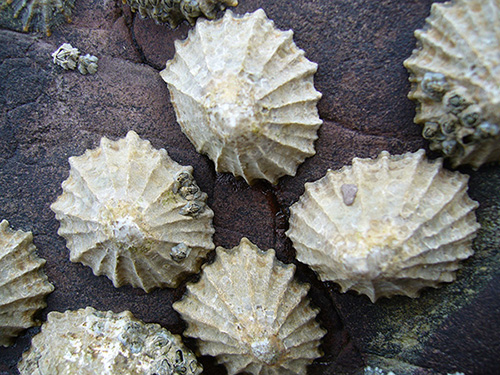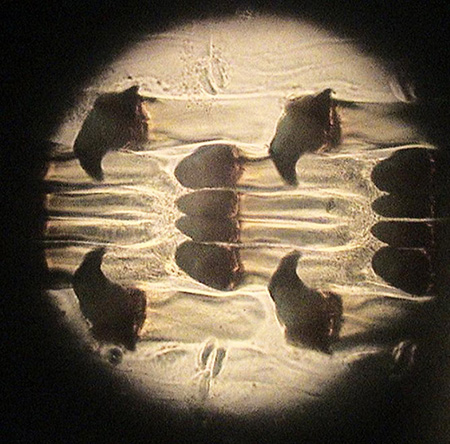Tensile Strength and Limpet Teeth
Today, tensile strength and limpet teeth. The University of Houston presents this series about the machines that make our civilization run and the people whose ingenuity created them.
We're walking our very large dog on a cheap leather leash. The leather has a tensile strength of around 2000 pounds per square inch (or psi). Its cross-sectional area is only a 24th of a square inch. The dog sees a cat and lunges. We pull back with an 83 lb. force. And that's just what it takes to break the leash!
Materials break when we reach their so-called ultimate tensile strength. And materials have vastly different strengths. (Next time, let's buy a nylon leash with a 10,000 psi strength. It should hold.)
Now, we need a benchmark if we want to compare materials. So let's pick a structural steel with a tensile strength of around 72,000 psi. How does that compare with materials in organic nature? Well-seasoned birch wood might be a tenth of that. For a long time we thought that spider silk was the strongest organic material. It can be three times as strong as common steel.
But we've recently learned something about limpets. A limpet is a kind of sea snail, shaped like a flat cone. It holds onto rocks, using its suction-cup underside. You may've heard of limpet mines. WW I and II divers sank enemy ships by placing limpet-shaped mines on their hulls.

Common Limpets
(Photo by Tango22. Licensed under CC BY-SA 3.0 via Wikimedia Commons)
A limpet eats by scraping algae off rocks with tiny teeth on its tongue. It turns out that limpet tooth material can be as much as thirteen times as strong as ordinary steel. If we could make it into a 1/16th inch wire, that wire could lift an automobile.
Teeth on a limpet tongue or radula docoglosse
(Photo by Eystein-thom Licensed under CC BY-SA 2.5 via Wikimedia Commons)
Back in 1979, the great writer/scientist Arthur C. Clark popularized an idea that would need a material at least that strong. It was to link Earth to a platform in geosynchronous orbit, 22,000 miles up. Instead of reaching orbit with a rocket, we'd use an elevator that rode up and down on a cable strong enough to support its own weight. The cable material had to be at least as strong as limpet teeth. Clark suggested mono-crystalline silicon - which happens to be about the same strength as the strongest limpet teeth.
NASA has since organized task forces to consider the idea. But finding a practical material with a really high tensile strength has been the sticking point. The 1991 discovery of carbon nano-tubes opened that door a bit further. Nanotubes are cylindrical carbon molecules of unlimited length. They aren't yet practical. But they do have the highest known tensile strength - nine million psi. That's over a hundred times the strength of common steel, and ten times the strength of limpet teeth.

NASA's concept drawing of the Space Elevator. (Image courtesy of NASA)
Now, the kicker in all this: It turns out that Limpet teeth are made of nano-fibers of a crystalline material (called Goethite) in a protein matrix. It's like the best of the carbon composites we presently use to build airplanes.
So we're getting there. But it does seem that, every time we have some great new idea, nature has thought of it first.
I'm John Lienhard at the University of Houston, where we're interested in the way inventive minds work.
See the Wikipedia articles on Ultimate Tensile Strength, Limpet, Limpet Mine, Fountains of Paradise, and Space Elevator. See also this Royal Society article on limpet teeth strength.
A useful paper on composite materials similar to limpet teeth: H. Gao, B. Ji, I L. Jager, E. Arzt, & P. Fratzl, Materials Become Insensitive to Flaws at Nanoscale: Lessons from Nature. PNAS, Vol. 100, No. 10, May 13, 2003.
A. C. Clark, The Fountains of Paradise. (Rosetta Books, 2012/1979). By the way, another book proposing the Space Elevator idea came out at the same time as Clark's book. it was: Sheffield, C., The Web Between the Worlds. New York: Ballantine Books, 1979, (1988 printing.)
A NASA space elevator study and a NASA video about the space elevator.
I've used the English unit of stress, pounds per square inch (psi), since it's more self-explanatory than the more widely-used MegaPascals (MPa) or GigaPascals (GPa). One MPa equals about 143 psi. The values that I've accepted are as follows, from least to greatest. (I picked most of these from ranges of values for the given material.)
Leather: 2000 to 5000 psi
Birch wood (not green and perpendicular to the grain): 7000 psi
Sea shell: 15,000 psi
Human hair: 56,000 psi
Structural steel: (ASTM A36) 72,000 psi
Spider Silk: 240,000 psi
Micro-Melt 10 Tough Treated Tool Steel (AISI A11): 755,000 psi
Limpet Teeth (upper value): 943,000 psi
Monocrystalline Silicon fiber: 1,015,000 psi
Carbon nanotubes: 9,138,000 psi
My thanks to colleagues in the material science area for helpful counsel: Kenneth White, Kasper Willam, and Yashashree Kulkarni.
This episode was first aired on March 9, 2015.
